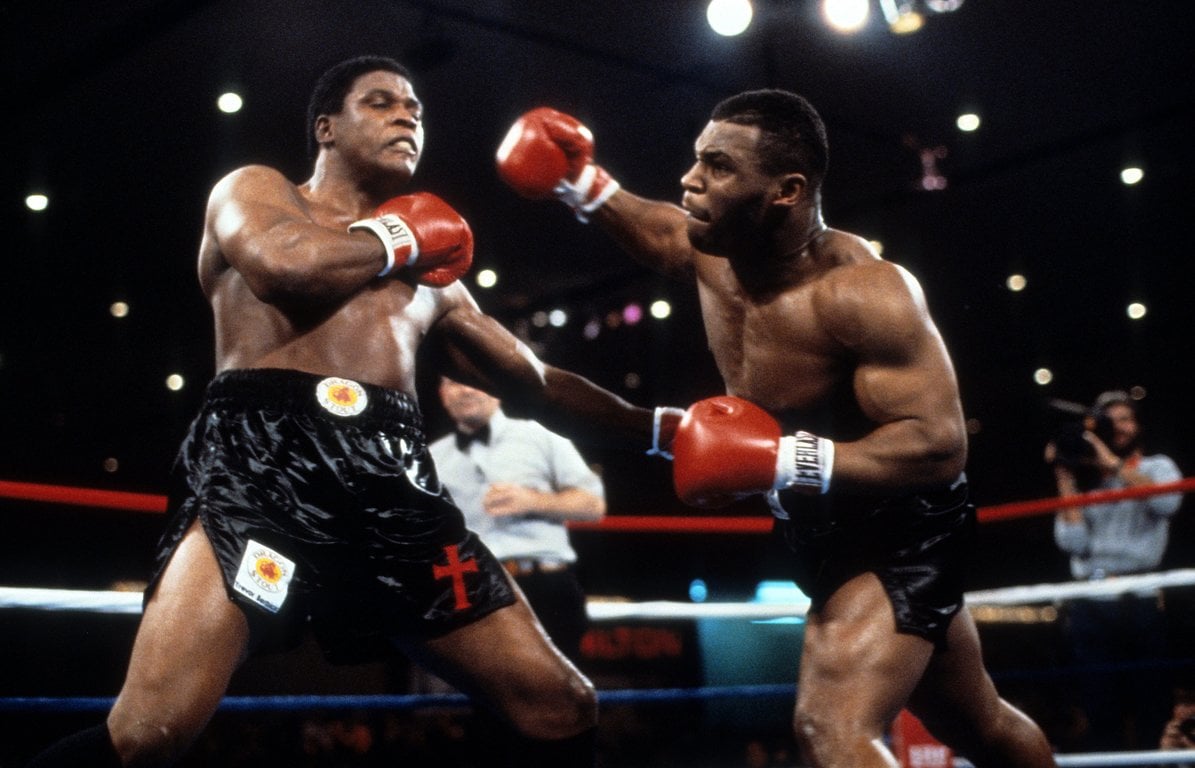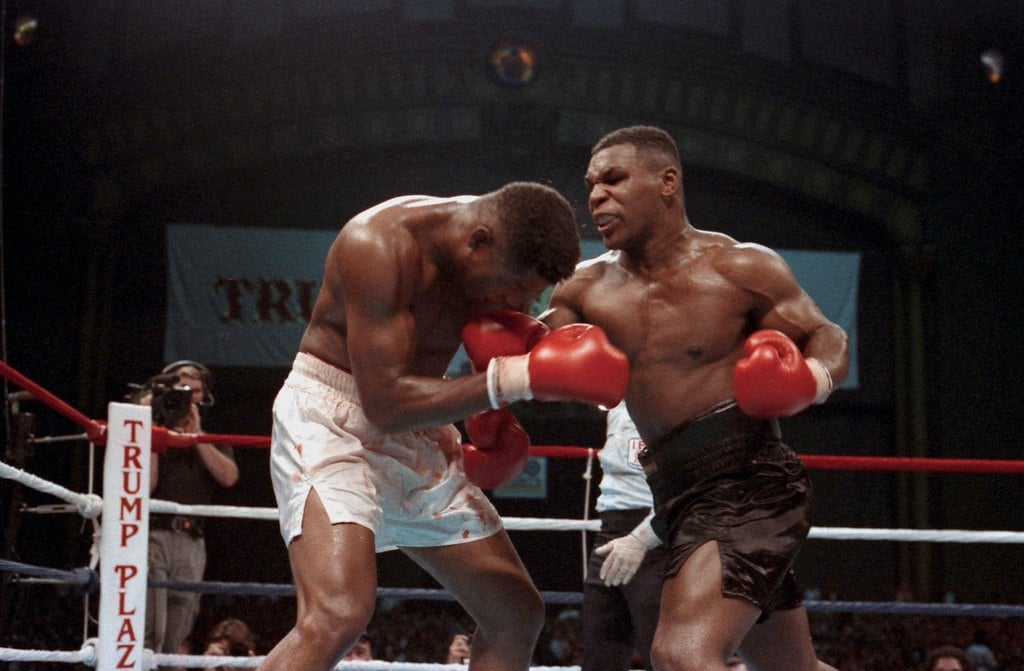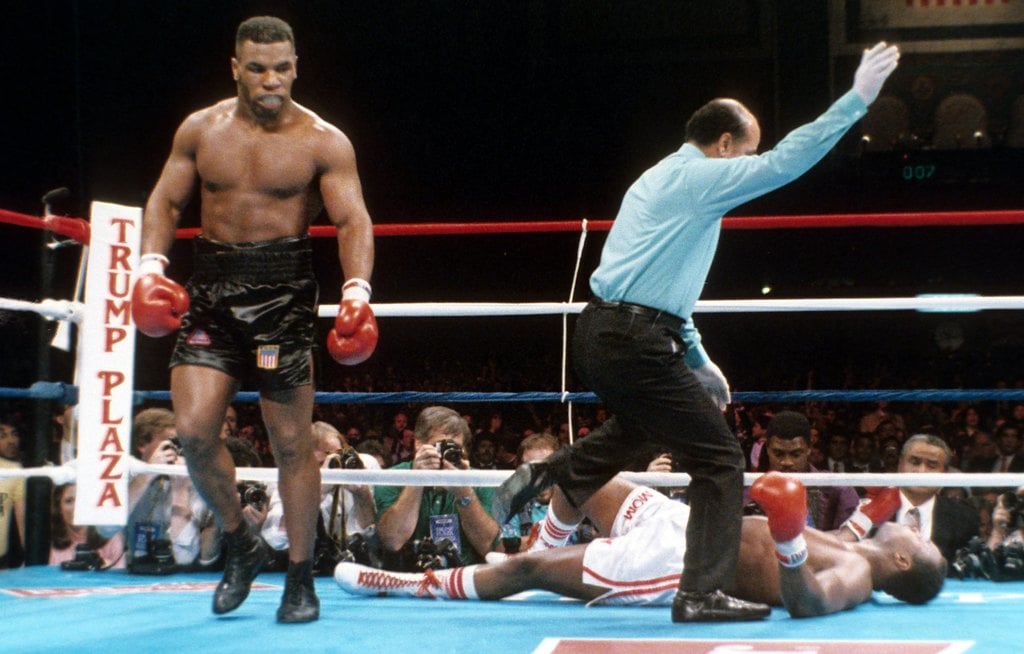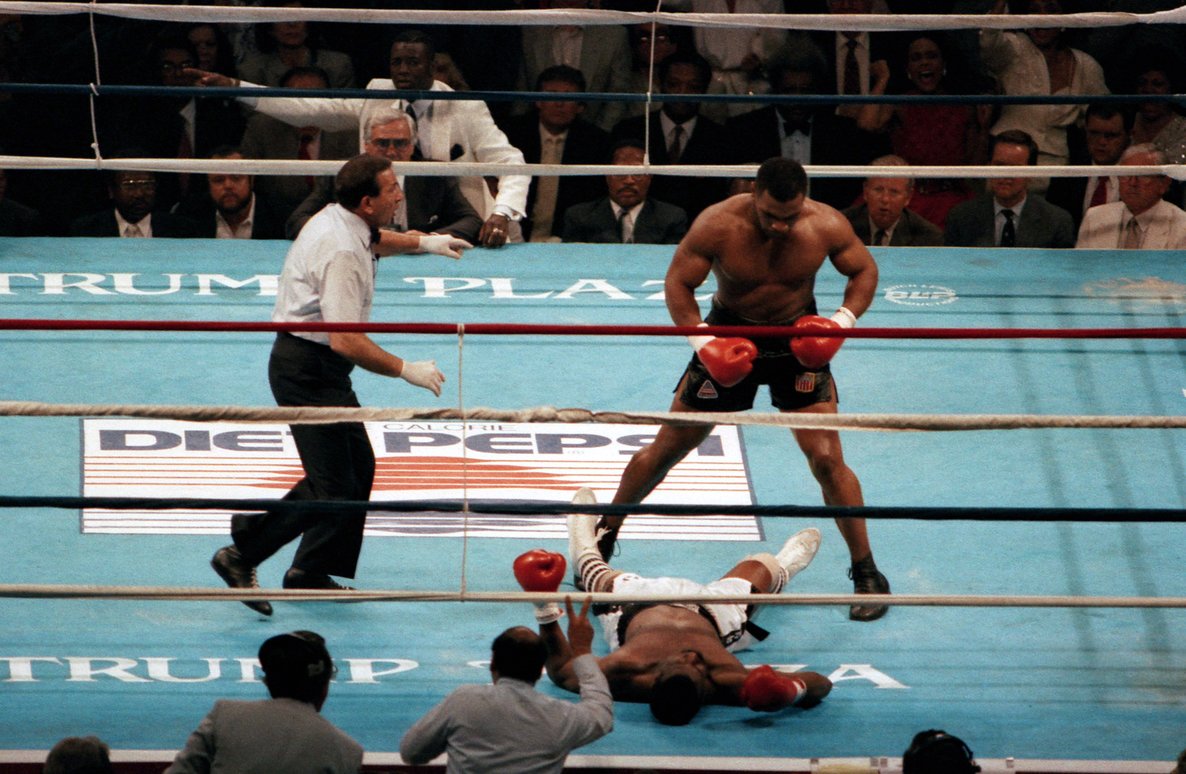Mike Tyson: The Greatest Hits

Editor’s Note: This feature originally appeared in the July 2020 issue of The Ring Magazine.
The style had been seen before, but the total package was unique.
Mike Tyson was a practitioner of the peek-a-boo style that was made famous by his mentor, Cus D’Amato. The legendary trainer-manager transformed Floyd Patterson into the first ever two-time heavyweight champion of the world and later guided Jose Torres to light heavyweight glory. Both Patterson and Torres carried their hands high, they were quick of foot, they moved their heads, they switched from body to head effortlessly and released sharp combinations.
D’Amato also founded a system where every punch was represented by a number. He would yell out numbers in different variations and the fighter would respond with the desired burst of punches. The numbers were set in stone, but stringing them together in combination made the system versatile, with the patterns changing depending on an opponent’s style and game plan. It was economical, strategically brilliant and ideal for an offensive force.
Tyson was the ultimate offensive force in the glamour division. He was bigger and more powerful than Patterson and, despite being a heavyweight, quicker than Torres. His killer instinct and thirst for combat was also visceral. D’Amato was positive that he had a diamond in the rough, a heavyweight champion-in-waiting, and his new charge soaked up knowledge like a sponge. Tyson didn’t reach the top of the tree as an amateur, but he was bred for the professional game.
On November 4, 1985, D’Amato passed away at the age of 77. By that time, Tyson was a super-hot prospect with 11 knockouts in as many fights and he had already captured the attention of the boxing world. Assistant trainer and former fighter Kevin Rooney continued to develop the young fighter from prospect to top-flight contender.
One year later, on November 22, 1986, Tyson was 27-0 with 25 KOs when he entered the ring to face WBC titleholder Trevor Berbick. The challenger dropped the Canada-based Jamaican twice in Round 2 to become the youngest heavyweight titleholder in boxing history at 20. D’Amato’s prophecy had come true.

Photo from The Ring archive
Over the next three years, Tyson wreaked havoc. In 1987, he dominated James “Bonecrusher” Smith and Tony Tucker, both on points, to claim the WBA and IBF titles, respectively. Those triumphs saw him recognized as the first undisputed heavyweight champion in almost a decade. Total dominance was achieved in June 1988 when Tyson butchered then-Ring Magazine and lineal champion Michael Spinks in just 91 seconds.
“I was probably at my best for Michael Spinks,” Tyson told The Ring before releasing the type of undiluted and uncut response for which he’s become synonymous. “I was married to the gold-digger wife, there was the gold-digger manager (Bill Cayton) and (promoter) Don King’s ripping me off. I’m being torn apart emotionally and physically. I’m all over movies, television, I’ve got lawsuits up the ass, but I turn in the greatest performance of my fuckin’ career. Isn’t that crazy?”
He’s settled now, but Tyson’s life during his professional career was certainly crazy. In what is still widely regarded as the biggest upset in boxing history, he lost his titles to Buster Douglas via 10th-round knockout in February 1990. Two years later, he was behind bars after being found guilty of rape, a crime which he insists to this day that he did not commit.
Returning to the ring in 1995, Tyson did regain WBA and WBC versions of the title, but he never again found the form that electrified the boxing world when he was at his peak. The second half of his career was marred by controversy – the shocking double ear-bite on Evander Holyfield in their 1997 rematch being at the top of the list – and he suffered losses to fighters that wouldn’t have lived with him in his heyday. Tyson retired for good in 2005 with a record of 50-6 (44 KOs) and was inducted into the Hall of Fame in 2011.
The former undisputed heavyweight champion spoke to The Ring about six of his greatest triumphs.

Tyson on the way to becoming the youngest heavyweight titleholder in boxing history. Photo from The Ring archive
Trevor Berbick
November 22, 1986, Hilton Hotel, Las Vegas • Titles: WBC heavyweight
“I’m in the Hilton Hotel one day, walking along this floor, and I hear someone knock on a door. The door opened and I hear Berbick say, ‘No, I’m not going to the gym today!’ That gave me the confidence that this bitch-ass motherfucker was slacking up. What a coincidence. What are the chances of me being on that floor? What are the chances? I was so excited that I ran back to the gym and worked out again. When I heard him say he didn’t want to train, I was like, ‘Now I’m gonna work out twice as hard!’ I was coming to avenge Muhammad Ali (Berbick outpointed a faded Ali in December 1981) and my intentions were to hurt him really bad. It was a good moment for me.”
Result: TKO 2

Tyson produced one of his most brutal finishes against Pinklon Thomas. Photo from The Ring archive
Pinklon Thomas
May 30, 1987, Hilton Hotel, Las Vegas, Outdoor Arena • Titles: WBA/WBC heavyweight
“He was very durable and a lot tougher than I thought he was. I hit him with some great shots early and he came back fighting. I was surprised by that, but somewhere around the fifth round (Editor’s note: It was Round 6), he ran into a left hook. He took that shot too, but I knew it was a bomb. The left hook stopped him in his tracks, so I threw everything I had at him and he went down. But he fought a great fight, and I had a great deal of respect for Pinklon Thomas. I was kind to him afterwards because my hero, Jack Dempsey, would brutalize someone and then go over and hug them, shake their hand and be respectful. I was copying my idol.”
Result: TKO 6

Tyson was tested by Tony Tucker but prevailed via wide unanimous decision. Photo from The Ring archive
Tony Tucker
August 1, 1987, Hilton Hotel, Las Vegas • Titles: IBF/WBA/WBC heavyweight
“Tucker was a really good fighter, but around that time I was partying a lot. I trained for a while, took two weeks off, hung out with some girls, came back, trained for three weeks, then went 12 rounds with him. In the first round, he really surprised me, catching me with a punch (left uppercut) that I didn’t see. Tucker was a magnificent fighter, but it was my time, and I stayed on top of him and didn’t give him a chance to breathe. There was no way for him to get his moves off and counterpunch, because I was all over him. Becoming undisputed champion was special because everything Cus and I talked about since I was 12 years old had come true. Imagine your father talking about you making something happen when you’re a kid and then you make it happen. Wow!”
Result: UD 12

Tyson wrecked Tyrell Biggs in the last heavyweight title bout to be scheduled for 15 rounds. Photo from The Ring archive
Tyrell Biggs
October 16, 1987, Convention Hall, Atlantic City • Titles: IBF/WBA/WBC heavyweight
“It crossed my mind that I could take the fight the full 15 rounds (Tyson-Biggs was the final heavyweight championship bout to be scheduled for 15), but I really didn’t want to. My mentor, Cus D’Amato, wasn’t just about beating a person; he wanted you to break his spirit, crush him, destroy him, never give your opponent the slightest idea that he can beat you. Biggs had plenty of courage, but they moved him a little too fast (Biggs fought Tyson in his 16th fight after less than three years of professional experience). He was a great amateur and could have gone a lot further as a pro if his management had slowed things down.”
Result: TKO 7

Tyson is the only man to knock out legendary former heavyweight champion Larry Holmes. Photo from The Ring archive
Larry Holmes
January 22, 1988, Convention Center, Atlantic City • Titles: IBF/WBA/WBC heavyweight
“At his best, I thought Holmes was magnificent – the king of his time. Again, this was about avenging Ali (Holmes stopped an aging Ali in October 1980), but after the fight, I mimicked Jack Dempsey by being respectful. I said that Holmes was a great fighter, and that was the truth. Would it have been a harder fight if he was younger? Hell yeah! Check this out: He came out of retirement and hadn’t fought for over two years when he fought me. But after that, he had 10 or 15 fights and started doing really good. He did really well with Evander Holyfield four years later.”
Result: TKO 4

Tyson gained universal recognition as heavyweight champ by smashing Michael Spinks in one round. Photo from The Ring archive
Michael Spinks
June 27, 1988, Convention Hall, Atlantic City • Titles: Undisputed heavyweight
“I was very confident that I would win that fight, but he was a great light heavyweight. I remember one day I was sparring Frank Bruno at Grossinger’s in upstate New York and Michael Spinks was there. He was in training for a light heavyweight fight, and he actually stayed and watched me spar. I could never have known then that we would fight one day, and that just shows you how unpredictable boxing can be. At heavyweight, Michael Spinks could be awkward to fight, and with Larry (Holmes) being a bit over the hill, that made things twice as difficult (Holmes lost two decisions to Spinks). But Spinks was too small for me, his knees were bad, he was an older guy and he didn’t really want to win.”
Result: KO 1
CLICK ON THE IMAGE BELOW TO PURCHASE THE NEW MIKE TYSON SPECIAL EDITION FROM THE RING SHOP:
Tom Gray is Associate Editor for Ring Magazine. Follow him on Twitter: @Tom_Gray_Boxing.















